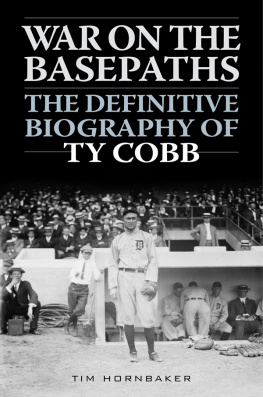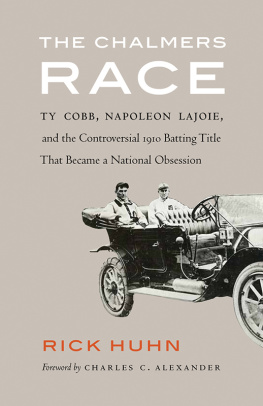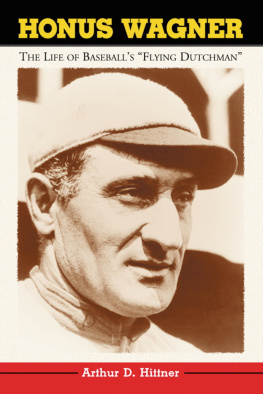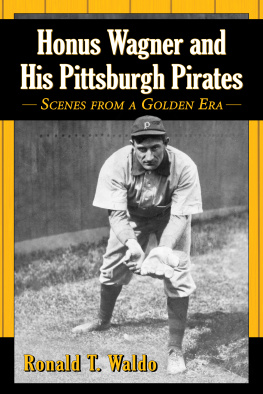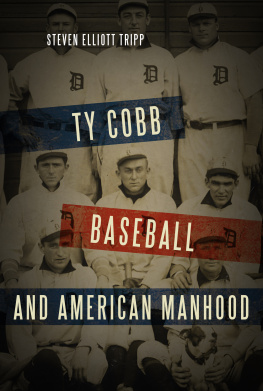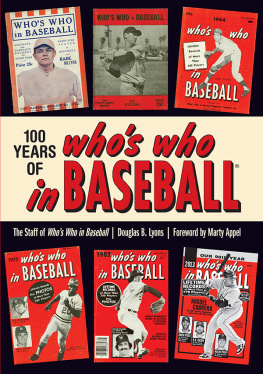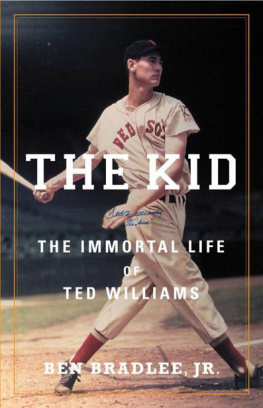Copyright 2015 by Tim Hornbaker
All rights reserved. No part of this book may be reproduced in any manner without the express written consent of the publisher, except in the case of brief excerpts in critical reviews or articles. All inquiries should be addressed to Sports Publishing, 307 West 36th Street, 11th Floor, New York, NY 10018.
Sports Publishing books may be purchased in bulk at special discounts for sales promotion, corporate gifts, fund-raising, or educational purposes. Special editions can also be created to specifications. For details, contact the Special Sales Department, Sports Publishing, 307 West 36th Street, 11th Floor, New York, NY 10018 or .
Sports Publishing is a registered trademark of Skyhorse Publishing, Inc., a Delaware corporation.
Visit our website at www.sportspubbooks.com.
10 9 8 7 6 5 4 3 2 1
Library of Congress Cataloging-in-Publication Data:
Hornbaker, Tim.
War on the basepaths : the definitive biography of Ty Cobb / Tim Hornbaker.
pages cm
ISBN 978-1-61321-765-8 (hardcover : alk. paper) 1. Cobb, Ty, 1886-1961. 2. Baseball players--United States--Biography. I. Title.
GV865.C6H67 2015
796.357092--dc23
[B]
2015004100
Jacket design by Rich Rossiter
Front jacket photo by Bain News Service
Back jacket photo courtesy of the National Baseball Hall of Fame Museum, Cooperstown, NY
Print ISBN: 978-1-61321-765-8
Ebook ISBN: 978-1-61321-793-1
Printed in the United States of America
To the love of my life, Jodi.
CONTENTS
INTRODUCTION
Off in the distance, a swell of commotion attracted onlookers and the spectacle likely resembled a circus. Regulars to the Northern California course were sidetracked by the unusual displayespecially for a Sunday on the links. All the attention seemed to be centered on one man, and to the uninformed observer, the individual was not unlike many others playing golf that day. He was in his mid-to-late forties, balding, and slightly overweight. In fact, nothing was particularly exceptional about him, visually speaking. But for those crowded around the man, wearing exceptionally large smiles and hoping for an autograph or handshake, they understood his significance. They realized they were around American sporting excellence, a one-of-a-kind legend that had cemented his place in the annals of Major League Baseball history. Their focus was none other than Tyrus Raymond Cobb, a twenty-four-year veteran of the national pastime.
On that day, February 2, 1936, the news broke that Cobb had received the largest amount of votes for modern inductees into the newly fashioned Baseball Hall of Fame, soon to be opened at Cooperstown, New York. He was essentially chosen number one by writers over all his contemporaries, including Babe Ruth, Honus Wagner, and literally thousands of other players. The 222 votes in his favor were just four short of unanimous, clearly indicative of his widespread esteem, and sportswriter Dick Farrington, amongst others, wondered how it happened that four experts overlooked him.
Playing hard was Cobbs keystone to success, and his intensity was visible on the field from his earliest games in small town Georgia until his final big league appearance seven years and five months before. Understandably, the image of the ex-ballplayer on the golf course in 1936 was a distant reality from the energetic and brawny competitor lighting basepaths afire during his prime. But even all those years later, Cobb continued to live and breathe the sport. Baseball was in his blood, and the honor bestowed upon him was a fitting acknowledgment of his extraordinary dedication to the game. As amazing as it might sound, when the exalted Georgia Peach retired in 1928, he had established ninety baseball records over the course of his career, creating a sphere of dominance that only he could claim. Cobb topped even Babe Ruth, who reportedly retired with seventy-eight baseball records.
As a member of the Detroit Tigers (190526) and Connie Macks Philadelphia Athletics (192728), Cobb put up statistics that were simply staggering. He owned a lifetime batting average of .367, 4,191 hits, 2,244 runs, 5,863 total bases, and 892 stolen bases, according to the official statistics recorded by Major League Baseball. [Other sources, including
Aside from his hitting abilities, Cobbs speed, trickiness, and base-running feats were a legend all their own. He was unlike his predecessors in that regard, and revolutionized the game by forcing rival teams to completely alter their defense to combat his methods. On the basepaths, he combined quickness and psychology to confuse opposition players, performing stunts that no one in their right mind ever conceived. And, because of this, he got away with these peculiar maneuvers with great frequency. That included stretching base hits into doubles, running from first to third on bunts, and stealing his way around the diamond to eventually score a run. Pilfering home plate was also a specialty, and Cobb managed to slip underneath the tag of a catcher 54 times in his career, the most in history. (Second in modern times is Max Carey, who had 33 steals of home with the Pittsburgh Pirates and Brooklyn Dodgers.)
Cobbs reputation wasnt as pristine as his statistics, and in his ever-determined fierceness, he did many things to get under the skin of both teammates and rivals. He talked trash on the field, which was part of his psychological campaign, slid into the bases hard, often looking to kick the ball free from the gloves of defenders, and wasnt afraid to mix it up physically. The success of his unorthodox tactics, in itself, was aggravating, and sportswriters and fans in opposing towns were caught up in a kind of love-hate relationship with Cobb, worshipping his unbelievable athletic feats and then letting him have it through boos and taunts, sometimes for no other good reason than he was the great Ty Cobb. Plus, anytime there was even a hint of controversy, the floodgates were open for criticism, and Cobb was the pincushion for a never-ending slew of condemnation.
One of the most enduring allegations surrounding Cobbs style of play was the claim that he slid into the bases with the metal spikes on the bottom of his shoes maliciously aimed at defenders with a vicious intent to injure. It was an ugly claim, and Cobb denied any deliberate attempt to injure fellow players countless times during and after his career. There were a couple moments, he admitted, when specific animosity turned spiteful, but in terms of his daily game play, slashing rivals was not a premeditated action. Another longstanding story that accompanied Cobbs life was his infamous jaunt into the grandstand in New York to pummel a verbally abusive fan. The partially handicapped spectator was the recipient of a swift beating and critics have used the event as evidence of Cobbs maniacal personality.
Of course, there were two sides to the story, but regardless of how many times Ty tried to explain his point of view, the scandalous version always reigned supreme. His colorful approach to baseball was bankable to sportswriters, and whenever the opportunity presented itself to feed into his intriguing image, journalists took advantage of the situation. The controversy sold newspapers and, since he consistently created excitement on and off the field, it was easy to lump a series of events together and portray him as baseballs number one rowdy. Interestingly, had Cobb performed in the television age, his amazing deeds and dynamic style would have fostered an even greater sensation. He was a must-see performer, and the marketability of Cobb as a mainstream TV celebrity would have been huge.

